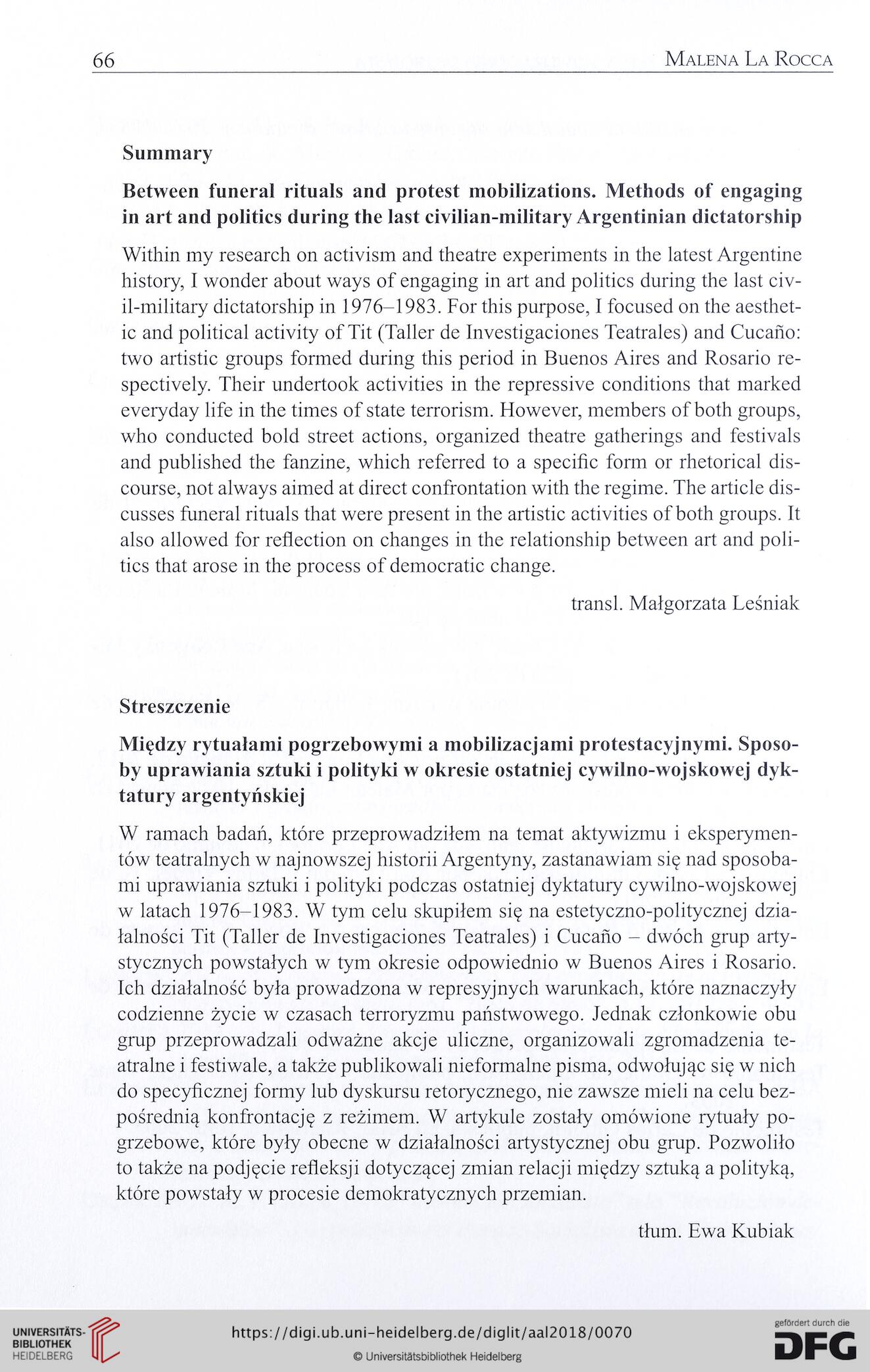66
Malena La Rocca
Summary
Between funeral rituals and protest mobilizations. Methods of engaging
in art and politics during the last civilian-military Argentinian dictatorship
Within my research on activism and theatre experiments in the latest Argentine
history, I wonder about ways of engaging in art and politics during the last civ-
il-military dictatorship in 1976-1983. For this purpose, I focused on the aesthet-
ic and political activity of Tit (Taller de Investigaciones Teatrales) and Cucaño:
two artistic groups formed during this period in Buenos Aires and Rosario re-
spectively. Their undertook activities in the repressive conditions that marked
everyday life in the times of state terrorism. However, members of both groups,
who conducted bold street actions, organized theatre gatherings and festivals
and published the fanzine, which referred to a specific form or rhetorical dis-
course, not always aimed at direct confrontation with the regime. The article dis-
cusses funeral rituals that were present in the artistic activities of both groups. It
also allowed for reflection on changes in the relationship between art and poli-
tics that arose in the process of democratic change.
transí. Małgorzata Leśniak
Streszczenie
Między rytuałami pogrzebowymi a mobilizacjami protestacyjnymi. Sposo-
by uprawiania sztuki i polityki w okresie ostatniej cywilno-wojskowej dyk-
tatury argentyńskiej
W ramach badań, które przeprowadziłem na temat aktywizmu i eksperymen-
tów teatralnych w najnowszej historii Argentyny, zastanawiam się nad sposoba-
mi uprawiania sztuki i polityki podczas ostatniej dyktatury cywilno-wojskowej
w latach 1976-1983. W tym celu skupiłem się na estetyczno-politycznej dzia-
łalności Tit (Taller de Investigaciones Teatrales) i Cucaño - dwóch grup arty-
stycznych powstałych w tym okresie odpowiednio w Buenos Aires i Rosario.
Ich działalność była prowadzona w represyjnych warunkach, które naznaczyły
codzienne życie w czasach terroryzmu państwowego. Jednak członkowie obu
grup przeprowadzali odważne akcje uliczne, organizowali zgromadzenia te-
atralne i festiwale, a także publikowali nieformalne pisma, odwołując się w nich
do specyficznej formy lub dyskursu retorycznego, nie zawsze mieli na celu bez-
pośrednią konfrontację z reżimem. W artykule zostały omówione rytuały po-
grzebowe, które były obecne w działalności artystycznej obu grup. Pozwoliło
to także na podjęcie refleksji dotyczącej zmian relacji między sztuką a polityką,
które powstały w procesie demokratycznych przemian.
tłum. Ewa Kubiak
Malena La Rocca
Summary
Between funeral rituals and protest mobilizations. Methods of engaging
in art and politics during the last civilian-military Argentinian dictatorship
Within my research on activism and theatre experiments in the latest Argentine
history, I wonder about ways of engaging in art and politics during the last civ-
il-military dictatorship in 1976-1983. For this purpose, I focused on the aesthet-
ic and political activity of Tit (Taller de Investigaciones Teatrales) and Cucaño:
two artistic groups formed during this period in Buenos Aires and Rosario re-
spectively. Their undertook activities in the repressive conditions that marked
everyday life in the times of state terrorism. However, members of both groups,
who conducted bold street actions, organized theatre gatherings and festivals
and published the fanzine, which referred to a specific form or rhetorical dis-
course, not always aimed at direct confrontation with the regime. The article dis-
cusses funeral rituals that were present in the artistic activities of both groups. It
also allowed for reflection on changes in the relationship between art and poli-
tics that arose in the process of democratic change.
transí. Małgorzata Leśniak
Streszczenie
Między rytuałami pogrzebowymi a mobilizacjami protestacyjnymi. Sposo-
by uprawiania sztuki i polityki w okresie ostatniej cywilno-wojskowej dyk-
tatury argentyńskiej
W ramach badań, które przeprowadziłem na temat aktywizmu i eksperymen-
tów teatralnych w najnowszej historii Argentyny, zastanawiam się nad sposoba-
mi uprawiania sztuki i polityki podczas ostatniej dyktatury cywilno-wojskowej
w latach 1976-1983. W tym celu skupiłem się na estetyczno-politycznej dzia-
łalności Tit (Taller de Investigaciones Teatrales) i Cucaño - dwóch grup arty-
stycznych powstałych w tym okresie odpowiednio w Buenos Aires i Rosario.
Ich działalność była prowadzona w represyjnych warunkach, które naznaczyły
codzienne życie w czasach terroryzmu państwowego. Jednak członkowie obu
grup przeprowadzali odważne akcje uliczne, organizowali zgromadzenia te-
atralne i festiwale, a także publikowali nieformalne pisma, odwołując się w nich
do specyficznej formy lub dyskursu retorycznego, nie zawsze mieli na celu bez-
pośrednią konfrontację z reżimem. W artykule zostały omówione rytuały po-
grzebowe, które były obecne w działalności artystycznej obu grup. Pozwoliło
to także na podjęcie refleksji dotyczącej zmian relacji między sztuką a polityką,
które powstały w procesie demokratycznych przemian.
tłum. Ewa Kubiak




